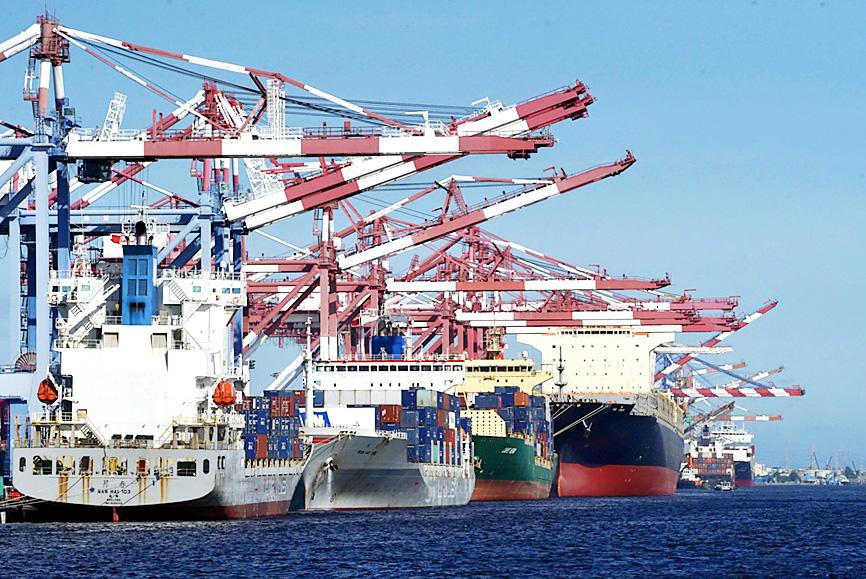Exports last month surged 35.1 percent year-on-year to US$36.65 billion, the second-highest level in history, as demand for electronics remained strong, while a low base meant that non-technology products posted faster growth, the Ministry of Finance said yesterday.
The improving global economy accounted for the impressive showing that is likely to extend into the second half of the year with the arrival of the high sales season, Department of Statistics Director-General Beatrice Tsai (蔡美娜) told an online news conference in Taipei.
“‘Hot’ is the most appropriate word to characterize the state of exports,” Tsai said, forecasting an upswing of 29 to 33 percent for this month year-on-year.

Photo: CNA
In the second quarter, exports grew 37.4 percent year-on-year to US$1.09 billion, while imports rose 36.4 percent to US$915.3 million, both beating last month’s forecasts by the Directorate-General of Budget, Accounting and Statistics.
That suggests that the nation’s export-focused economy is likely to emerge from the domestic COVID-19 outbreak unscathed, despite a sharp decline in consumer activity.
Outbound shipments of electronic products last month grew 29.8 percent to a record US$14.51 billion, as demand for chips hit a new peak, Tsai said.
Exports of optical products, including flat panels and camera lenses, rose 29.5 percent to US$1.12 billion, data showed.
Smartphone camera lens maker Largan Precision Co (大立光) earlier this week said that its sales would pick up this month after an 18.51 percent year-on-year fall last month due to the slow season and the loss of major client Huawei Technologies Co (華為).
Shipments of plastic, base metal, chemical and mineral products registered steeper growth of 46.6 to 87.4 percent, as local firms benefited from increased infrastructure spending by the US and other nations, Tsai said, adding that a low base last year also lent support.
Exports to China, ASEAN, Japan, the US and Europe all grew by double-digit percentage points as vaccination programs enabled the world to gradually shake off the threat of the COVID-19 pandemic.
Imports last month surged 42.3 percent to US$31.51 billion, giving Taiwan a trade surplus of US$5.1 billion, data showed.
Imports of agricultural and industrial materials grew 51.8 percent to US$21.95 billion, while imports of capital equipment increased 24.5 percent to US$5.5 million, the ministry said, adding that local technology firms are expanding their capacity to meet demand.
In the first six months of the year, exports advanced 31 percent year-on-year to US$206.91 billion, while imports expanded 28.6 percent to US$175.1 billion, the ministry said, while adding that uncertainty remains due to the spread of more transmissible variants of SARS-CoV-2.

CHIP RACE: Three years of overbroad export controls drove foreign competitors to pursue their own AI chips, and ‘cost US taxpayers billions of dollars,’ Nvidia said China has figured out the US strategy for allowing it to buy Nvidia Corp’s H200s and is rejecting the artificial intelligence (AI) chip in favor of domestically developed semiconductors, White House AI adviser David Sacks said, citing news reports. US President Donald Trump on Monday said that he would allow shipments of Nvidia’s H200 chips to China, part of an administration effort backed by Sacks to challenge Chinese tech champions such as Huawei Technologies Co (華為) by bringing US competition to their home market. On Friday, Sacks signaled that he was uncertain about whether that approach would work. “They’re rejecting our chips,” Sacks

NATIONAL SECURITY: Intel’s testing of ACM tools despite US government control ‘highlights egregious gaps in US technology protection policies,’ a former official said Chipmaker Intel Corp has tested chipmaking tools this year from a toolmaker with deep roots in China and two overseas units that were targeted by US sanctions, according to two sources with direct knowledge of the matter. Intel, which fended off calls for its CEO’s resignation from US President Donald Trump in August over his alleged ties to China, got the tools from ACM Research Inc, a Fremont, California-based producer of chipmaking equipment. Two of ACM’s units, based in Shanghai and South Korea, were among a number of firms barred last year from receiving US technology over claims they have

It is challenging to build infrastructure in much of Europe. Constrained budgets and polarized politics tend to undermine long-term projects, forcing officials to react to emergencies rather than plan for the future. Not in Austria. Today, the country is to officially open its Koralmbahn tunnel, the 5.9 billion euro (US$6.9 billion) centerpiece of a groundbreaking new railway that will eventually run from Poland’s Baltic coast to the Adriatic Sea, transforming travel within Austria and positioning the Alpine nation at the forefront of logistics in Europe. “It is Austria’s biggest socio-economic experiment in over a century,” said Eric Kirschner, an economist at Graz-based Joanneum

BUBBLE? Only a handful of companies are seeing rapid revenue growth and higher valuations, and it is not enough to call the AI trend a transformation, an analyst said Artificial intelligence (AI) is entering a more challenging phase next year as companies move beyond experimentation and begin demanding clear financial returns from a technology that has delivered big gains to only a small group of early adopters, PricewaterhouseCoopers (PwC) Taiwan said yesterday. Most organizations have been able to justify AI investments through cost recovery or modest efficiency gains, but few have achieved meaningful revenue growth or long-term competitive advantage, the consultancy said in its 2026 AI Business Predictions report. This growing performance gap is forcing executives to reconsider how AI is deployed across their organizations, it said. “Many companies